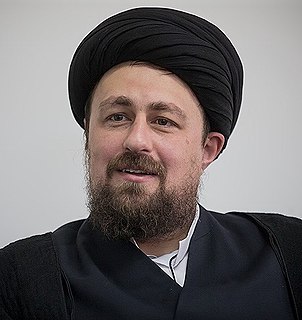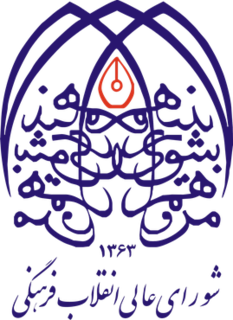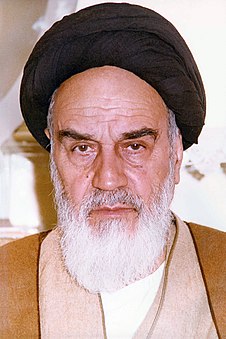
Hussein-Ali Montazeri was an Iranian Shia Islamic theologian, Islamic democracy advocate, writer and human rights activist. He was one of the leaders of the Iranian Revolution in 1979. He was once the designated successor to the revolution's Supreme Leader Ayatollah Khomeini, with whom he had a falling-out in 1989 over government policies that Montazeri claimed infringed on people's freedom and denied them their rights. Montazeri spent his later years in Qom, and remained politically influential in Iran, especially to the reformist movement. He was widely known as the most knowledgeable senior Islamic scholar in Iran and a Grand Marja of Shia Islam.

The Expediency Discernment Council of the System is an administrative assembly appointed by the Supreme Leader and was created upon the revision to the Constitution of the Islamic Republic of Iran on 6 February 1988. It was originally set up to resolve differences or conflicts between the Majlis and the Guardian Council, but "its true power lies more in its advisory role to the Supreme Leader." According to Hooman Majd, the Leader "delegated some of his own authority to the council — granting it supervisory powers over all branches of the government" following President Mahmoud Ahmadinejad's election in 2005.

The Iranian reformists are a political faction in Iran that support former President Mohammad Khatami's plans to change the Iranian political system to include more freedom and democracy. Iran's "reform era" is sometimes said to have lasted from 1997 to 2005—the length of Khatami's two terms in office. The Council for Coordinating the Reforms Front is the main umbrella organization and coalition within the movement; however, there are reformist groups not aligned with the council, such as the Reformists Front.
Special Clerical Court, or Special Court for Clerics is a special Iranian court system for prosecuting Islamic clergyman and scholars accused of improper activity and conduct unbecoming of a cleric. The court functions independently of the regular Iranian judicial framework, and is accountable only to the Supreme Leader. The most prominent prosecution to have occurred was that of Abdollah Noori who became the most senior Islamic politician to be sentenced to prison since the Iranian Revolution when he was sentenced to five years in prison for political and religious dissent in 1999.

Mir-Hossein Mousavi Khameneh is an Iranian reformist politician, artist and architect who served as the seventy-ninth and last Prime Minister of Iran from 1981 to 1989. He was a reformist candidate for the 2009 presidential election and eventually the leader of the opposition in the post-election unrest. Mousavi served as the president of the Iranian Academy of Arts until 2009, when Conservative authorities removed him.

The Prime Minister of Iran was a political post in Iran that had existed during several different periods of time starting with the Qajar era until its most recent revival from 1979 to 1989 following the Iranian Revolution.

The Islamic Republican Party formed in mid-1979 to assist the Iranian Revolution and Ayatollah Khomeini establish theocracy in Iran. It was disbanded in May 1987 due to internal conflicts.
The Guardianship of the Islamic Jurist, also called the Governance of the Jurist, is a post-Occultation theory in Shia Islam which holds that Islam gives a faqīh custodianship over people. Ulama supporting the theory disagree over how encompassing custodianship should be. One interpretation – Limited Guardianship of the Islamic Jurist – holds that guardianship should be limited to non-litigious matters including religious endowments (Waqf) judicial matters and the property for which no specific person is responsible. Another – Absolute Guardianship of the Islamic Jurist – maintains that Guardianship should include all issues for which ruler in the absence of Imams have responsibility, including governance of the country. The idea of guardianship as rule was advanced by the Ayatollah Ruhollah Khomeini in a series of lectures in 1970 and now forms the basis of the Constitution of the Islamic Republic of Iran. The constitution of Iran calls for a faqih, or Vali-ye faqih, to serve as the Supreme Leader of the government. In the context of Iran, Guardianship of the Islamic Jurist is often referred to as "rule by the jurisprudent", or "rule of the Islamic jurist".

The Society of Seminary Teachers of Qom was founded in 1961 by the leading Muslim clerics of Qom, established by the students of Ayatollah Khomeini after his exile to Iraq in order to organize political activities of Khomeini's followers and promote his revolutionary interpretation of Islam such as the idea of Islamic government. Since the 1979 revolution, it has largely become the body to keep the regime's registrar of who counts as a grand ayatollah, an Ayatollah and a Hojjat ul Islam. It has a head who is appointed by the Supreme Leader of the Islamic Republic. It currently heads the Supreme Council of Qom Hawzas, and proposes judges to the judiciary system. The body gained international prominence when it announced in 1981 that Ayatollah Shariatmadati was no longer a source of emulation (marja'). It has demoted a number of clerics over the last three decades. A recent case was that of Ayatollah Yousef Saanei who for his solidarity with the green movement was demoted from marja' to hojatoleslam. The Society also include Ayatollah Sistani on its list.

Grand Ayatollah Mohammad Reza Golpaygani was an Iranian Shia Islam cleric and marja. He was born in Gogad village, near the city of Golpaygan, Iran. He was taught preliminary studies by his father, Mohammad Bagher. At the age of 9, his father died, and he moved to Golpaygan to continue his studies. At the age of 20, he moved to Arak to study under Abdul-Karim Ha'eri Yazdi. After Ha'eri Yazdi and Ayatollah Mohammad Taghi Khansari founded the hawza of Qom, he moved there and delivered lectures in the Islamic Seminary. He was one of the highest-ranking Islamic clergy to participate in the Islamic Revolution of 1979, and a one-time serious contender to succeed Ruhollah Khomeini as the Supreme Leader of Iran in 1989. However, his candidacy was voted down by the Assembly of Experts, in favor of the eventual successor and current leader, Ali Khamenei.

Sayyid Hassan Khomeini is an Iranian cleric. He has been called "the most prominent" grandchild of Ruhollah Khomeini, who had 15 grandchildren in total and the one "who many think could have a promising political future".
Prime ministership of Mir-Hossein Mousavi were the third and fourth government of Iran after the Iranian Revolution. At that time, Ali Khamenei was the president.

In August 1981, President Mohammad-Ali Rajai and Prime Minister Mohammad-Javad Bahonar were assassinated in an explosion. Ali Khamenei was then elected as the third president of Iran in the Iranian presidential election, October 1981. He put forward Ali Akbar Velayati as his prime minister, but the Iranian parliament did not give him the vote of confidence, and he was defeated with a vote of 80 to 74. Subsequently, Ali Khamenei, though he had strong disagreements with Mousavi, as a compromise with the left-leaning parliament, agreed to offer him, Mousavi, for the post of premier. On 28 October, the parliament approved Mousavi with a vote of 115 to 39. Mousavi became the 79th Prime Minister of Iran on 31 October 1981, and remained the prime minister of Iran until 3 August 1989, for eight years.

The Supreme Council of the Cultural Revolution is a conservative-dominated body based in Qom, was set up at the time of Ayatollah Khomeini. Its decisions can only be overruled by Iran's Supreme Leader. Most of its members were appointed by Ali Khamenei, Khomeini's successor.
The President of Iran is ex officio the chairman of the Council.

The Supreme Leader of Iran, also referred to as Supreme Leader of the Islamic Revolution, but officially called the Supreme Leadership Authority, is the head of state as well as the ultimate political and religious authority of the Islamic Republic of Iran. The armed forces, judiciary, state television, and other key government organizations are subject to the Supreme Leader. The current longtime officeholder, Ali Khamenei, has been issuing decrees and making the final decisions on economy, environment, foreign policy, education, national planning, and everything else in Iran. Khamenei also makes the final decisions on the amount of transparency in elections, and has dismissed and reinstated presidential cabinet appointees. The Supreme Leader directly chooses the ministers of Defense, Intelligence and Foreign Affairs, as well as certain other ministers, such as the Science Minister. Iran's regional policy is directly controlled by the office of the Supreme Leader with the Ministry of Foreign Affairs' task limited to protocol and ceremonial occasions. All of Iran's ambassadors to Arab countries, for example, are chosen by the Quds Corps, which directly report to the Supreme Leader.
Events from the year 1989 in Iran.
Events from the year 1983 in Iran.















